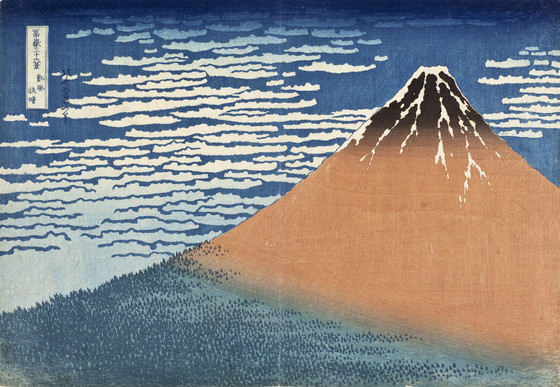This print, often called Red Fuji, is the greatest design in Hokusai's most famous series of prints, Thirty-six Views of Mt. Fuji....
This print, often called Red Fuji, is the greatest design in Hokusai's most famous series of prints, Thirty-six Views of Mt. Fuji. It is also one of the most successful works in the history of printmaking. Red Fuji epitomizes the phrase "economy of means": it uses only three colors and a single outline that pulls the weight of the composition into tense asymmetry. The perfection of this composition grew from Hokusai's long study and analysis of form, and his use of line, circles, triangles, and squares to create balanced and monumental images. The resulting impression is one of massive weight and power.
Thirty-six Views of Mt. Fuji
In Thirty-six Views of Mt. Fuji, Hokusai's most acclaimed series of prints, he distilled all of his compositional and narrative genius. His aim in producing the series was to show the most famous landmark in Japan in all seasons, in all possible scenic variations, and in a multitude of atmospheric conditions. He succeeded in evoking the reaction of the local inhabitants to this monumental volcanic formation. Red Fuji is the only print in the series that shows no inhabitants: it concentrates wholly on the mountain. Hokusai shows Fuji during the ominous moments before a storm blows in from the south.
Prior to this series, much of the subject matter in Japanese prints revolved around the ukiyo (floating world), the world of transient pleasures that included courtesans and actors. When these subjects were prohibited by reform law during the Kansei era (1789-1801), legendary and historical prints entered the genre. After travel restrictions were relaxed, resulting in a "travel boom" among the general populace in the late 1820s and early 1830s, prints as travel souvenirs became popular, especially Hokusai's Thirty-six Views of Mt. Fuji. Mt. Fuji, as with many of the awe-inspiring geographic features in Japan , is considered to be the home of a kami (Shinto deity) and is a center for both Shinto veneration and Buddhist mountain-worshipping cults. During Hokusai's lifetime, pilgrims to Fuji were his main customers for these prints.
The total number of prints in this series is forty-six: the thirty-six that comprise the original set plus a supplement of ten. Early impressions of the original set were done with a Prussian blue outline, following a brief fad for this color, but later impressions and all supplementary prints have the usual black outlines.
More...



